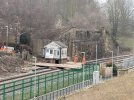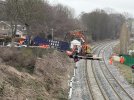GRALISTAIR
Established Member
Indeed!Or quite possibly to minimise disruption after the TRU upgrade has been completed. Imagine it being completed then shut again not long after to replace track, it would be a PR disaster.
Indeed!Or quite possibly to minimise disruption after the TRU upgrade has been completed. Imagine it being completed then shut again not long after to replace track, it would be a PR disaster.
I noticed there’s a caption in the recent video, (at 1m 18s), that refers to installing a ‘maintenance storage area’, might that be what you saw?I should add that the TRU work-site at Morley station was wound down, with machinery and portakabins removed etc around Christmas. However, there were workmen there 10 days or so ago tarmac-ing the site, not entirely sure why they would do that after leaving?
Some very elderly sleepers by Cottingley:Or quite possibly to minimise disruption after the TRU upgrade has been completed. Imagine it being completed then shut again not long after to replace track, it would be a PR disaster.

I noticed there’s a caption in the recent video, (at 1m 18s), that refers to installing a ‘maintenance storage area’, might that be what you saw?
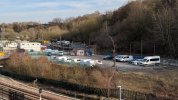
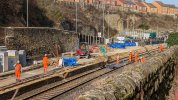

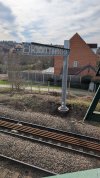
they don't look particularly old - or at all bad to me. Nice free-draining ballast (on top anyway) and no rot visible. One minor split which is irrelevant to the strength lengthwise.Some very elderly sleepers by Cottingley:
View attachment 175768
The similar wooden sleepers/track on the bed by the White Rose Centre were replaced last year, so maybe these will be replaced in due course?
Can't be many wooden sleepers left on the National Rail network, surely? From my casual observation even most heritage railways seem to have moved over to pre-stressed concrete
Woods will still have to be used in certain locations like bridge decks with a weight loading issue and tunnels if not sufficient ballast depth for concretes. Those are in very good condition at least a decade of life left in them.Some very elderly sleepers by Cottingley:
View attachment 175768
The similar wooden sleepers/track on the bed by the White Rose Centre were replaced last year, so maybe these will be replaced in due course?
Can't be many wooden sleepers left on the National Rail network, surely? From my casual observation even most heritage railways seem to have moved over to pre-stressed concrete.
Still some on the WCML just north of Carlisle platform 3 with 95lb bullhead.Woods will still have to be used in certain locations like bridge decks with a weight loading issue and tunnels if not sufficient ballast depth for concretes. Those are in very good condition at least a decade of life left in them.
I believe they are gradually being superseded by synthetic ones.Woods will still have to be used in certain locations like bridge decks with a weight loading issue and tunnels if not sufficient ballast depth for concretes. Those are in very good condition at least a decade of life left in them.
The track system there looks fine. The timber split is brittle, not rot. The fastening system is also in good condition, with the main giveaway the square coach screw heads (not rounded off through decades of maintenance degradation). Topped off with well maintained ballast free from vegetation that is level with the sleeper tops.Some very elderly sleepers by Cottingley:
No timber sleepers any more in renewals - composite are the default in place of concrete. Exceptions in tunnels, guard rail systems and for use as S&C bearers.Woods will still have to be used in certain locations like bridge decks with a weight loading issue and tunnels if not sufficient ballast depth for concretes. Those are in very good condition at least a decade of life left in them.
Can it accommodate an increase in linespeed through? 75mph to 90mph I believe is the plan.The track system there looks fine. The timber split is brittle, not rot. The fastening system is also in good condition, with the main giveaway the square coach screw heads (not rounded off through decades of maintenance degradation). Topped off with well maintained ballast free from vegetation that is level with the sleeper tops.
Based on that picture yes it can definitely. Looks absolutely fine.Can it accommodate an increase in linespeed through? 75mph to 90mph I believe is the plan.
Some very elderly sleepers by Cottingley:
Can it accommodate an increase in linespeed through? 75mph to 90mph I believe is the plan.
The captions say that there isn’t electrification metalwork on the main lines - it’s just the sidingsLatest Sarah Bell video shows gantrys (4 track wide) in place at Hllhouse.
Impressive to see they have most of the fittings already atrached.
Difficult to tell but probably over the 4 new sidings for stabling Northern units.
K
A lot at Carnforth but with flat bottom railStill some on the WCML just north of Carlisle platform 3 with 95lb bullhead.
I'm not sure how much I can give away on the forums, and I can never rule out plans that I am not personally involved in (and therefore have no reason to see), but I personally haven't seen anything on the few signalling plans that I am privy to, to indicate a line speed increase to 90mph through Cottingley.Can it accommodate an increase in linespeed through? 75mph to 90mph I believe is the plan.
Are these new feeding structures on the Doncaster line or on Huddersfield field line and you were observing them from the mainline?Passing northwards on the DOL lines (Doncaster - Leeds) this morning, I noticed that a number of new OLE structures beyond Cottingley now have "stovepipes"/"drop tubes".
The new structures were on the Huddersfield Lines (MDL1), while I travelled north on an XC service on the mainline (or Doncaster Lines).Are these new feeding structures on the Doncaster line or on Huddersfield field line and you were observing them from the mainline?
Sounds like a classic case of 'plans on paper vs reality'Can it accommodate an increase in linespeed through? 75mph to 90mph I believe is the plan.
I'm not sure how much I can give away on the forums, and I can never rule out plans that I am not personally involved in (and therefore have no reason to see), but I personally haven't seen anything on the few signalling plans that I am privy to, to indicate a line speed increase to 90mph through Cottingley.
As stated, the files I have access to don't indicate a 90mph line speed increase, but I will not rule out the possibility of it being in a document that I simply don't have access to; in fact it seems quite likely that there is a lot more under the surface than the rather limited suite of LAPs available to me.Well in the early posts to this thread somebody shared a presentation which included the planned line speed increases from Manchester Victoria all the way to York. There was a section of 90mph envisaged through Cottingley, however this could now have changed. There was also 80mph through Clayton vale area in East Manchester but as far as I am aware it remains at 75mph even after all the civils regarding Electrofication have been completed.
I'm sure I saw an early plan for the Hope Valley scheme through Dore showing higher line speeds across a junction than are now being operated. I asked why and was told that points for a higher speed cost a lot more and couldn't be made in the UK in time. Which is when I got an explanation of curvature and cants across junctions and the specialised business of manufacturing such points from the right types of steel and the waiting list to get such tailor made items for only slightly higher speeds!Well in the early posts to this thread somebody shared a presentation which included the planned line speed increases from Manchester Victoria all the way to York. There was a section of 90mph envisaged through Cottingley, however this could now have changed. There was also 80mph through Clayton vale area in East Manchester but as far as I am aware it remains at 75mph even after all the civils regarding Electrofication have been completed.
Passing northwards on the DOL lines (Doncaster - Leeds) this morning, I noticed that a number of new OLE structures beyond Cottingley now have "stovepipes"/"drop tubes".
The new structures were on the Huddersfield Lines (MDL1), while I travelled north on an XC service on the mainline (or Doncaster Lines).
Could it have been the PWI presentation here, which is only to Leeds?Well in the early posts to this thread somebody shared a presentation which included the planned line speed increases from Manchester Victoria all the way to York. There was a section of 90mph envisaged through Cottingley, however this could now have changed. There was also 80mph through Clayton vale area in East Manchester but as far as I am aware it remains at 75mph even after all the civils regarding Electrofication have been completed.
I found this talk on the Permanent Way Institute (PWI) Youtube channel which gives an up to date overview of the project. There's too much to summarise but there's an up to date line speed graph, discussion of Huddersfield station track layout and plenty more. It's a long watch but worth a look.
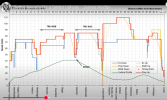
It definitely included the Leeds to York section so it couldn't have been this one, although this too includes 90 mph through Cottingley albeit in one direction only. However the speed profile I saw did include 80mph through East Manchester and also higher speeds through the 3 mile Standedge tunnel.Could it have been the PWI presentation here, which is only to Leeds?
YES! This was the one most definitely. I too remember this bit;This was the Presentation. It is also where the famous "You don't need to go fast - just don't go slow" comment came.
The key bits start at 37.00 minutes and the line speed profile at 38:25 - one of my favourite presentations of all time.
Thank you for sharing and showing that my memory is actually quite good (sometimes)you don't need to go fast - just don't go slow
